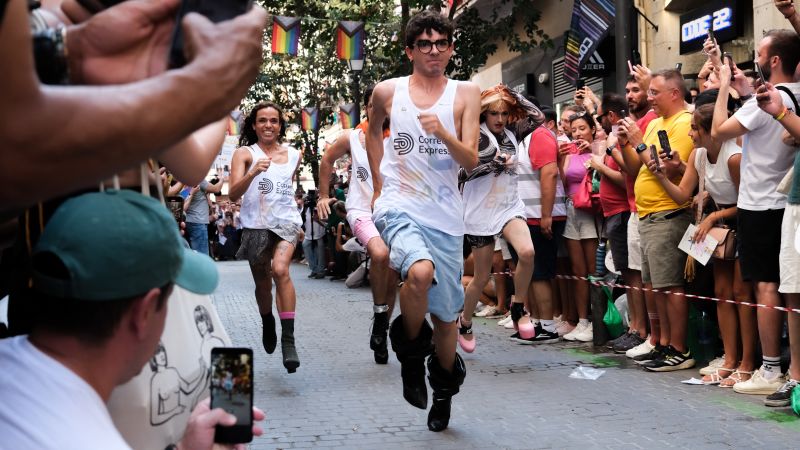Spectators gathered on the cobblestone streets of Madrid’s Chueca neighborhood this week to witness one of Spain’s most unique events: the “Carrera de Tacones,” or high-heel race. Held annually as part of the city’s Pride celebrations, this race features competitors—primarily men in towering heels—sprinting down Calle de Pelayo. The event, which has been a staple for decades, was filled with whoops, cheers, and gasps as participants tried to outpace each other on Thursday, some stumbling in their unruly heels towards the finish line.
The event is not just a spectacle but a carefully planned celebration of Spain’s LGBTQ+ community, growing in popularity each year. “There will be seven races in total, much more than in recent years,” explained David Bonillo, the event’s manager since 2014. Bonillo started his day early at LL Bar, the iconic drag establishment that founded the competition in the late 1990s. “Six qualification races at 6pm. Then, the winners will face-off in the grand finale.”
Strict Rules and Fierce Competition
The Carrera de Tacones is governed by strict rules, ensuring fairness and safety. In the back room of a neighboring sportswear shop, where runners check-in before the race, staff members were busy taping participants’ shoes tightly to their ankles with black duct tape to prevent sprains and breaks. Near the store’s entrance, another staff member measured the heels with a well-worn tape, disqualifying any footwear under 10 cm high (about four inches).
Edson Escolar, a racer from Guatemala, was visibly disappointed when his blue stilettos were deemed two centimeters too short. “In Guatemala, we have Pride but it’s nothing like this. People there still look at you funny if you wear feminine clothes. Here, I feel so free,” he shared. Despite his hopes, Escolar was not seen at the starting line.
“We have a couple of rules to keep the race fair,” said Bonillo. “It’s important to maintain them so we can continue to organize this special tradition for years to come.”
Historical Roots and Cultural Significance
Few in Spain understand the race’s humble beginnings better than the drag queen known as Chumina Power. A prominent figure in Chueca, Power presented the race with a mix of singing, dancing, and commentary from a small platform near the finish line. She attended the event’s first race and began performing at LL Bar a few years later.
“The high heel race has been going on for 30 years, but at first, it was a tiny event with just a few people,” she recalled. “Pride itself was also small. The first celebrations in this country took place across only two small streets here, and Calle de Pelayo was one of them.”
“Most people didn’t come to Pride to demonstrate because it was still frowned upon back then,” Power said. “But the race grew with Madrid Pride, which is now one of the most important festivals in Spain.”
Madrid Pride, known as “Orgullo Gay de Madrid,” began as a political demonstration in 1978. By 2019, it had become Europe’s largest Pride celebration, drawing around two million visitors annually.
The Race and Its Challenges
As Power returned to the stage, racers began their final stretches, anticipation growing among the crowd. Each qualifying heat featured a mix of experience and youth, with some runners anxious and others joking together, drinks in hand. Brian Healy, originally from Ireland and a participant since 2018, shared his experiences. “I bought these shoes online from China, and something felt different when I put them on,” he laughed. “They were so cheap they didn’t even have a left and right one! They were both the same, but I’ve kind of got used to it now.”
For first-time racer Pablo Lopez, who wore long, loose black leather boots, the experience was nerve-wracking. “I’m really scared,” Lopez admitted with a shy smile. “I practiced a little bit at home, walking and running slowly, but the ground is different here.”
Before the final race, shoe fatigue became apparent. One finalist lifted their leg to reveal bloodied toes and a shredded shoe. The final race included a surprise challenge: all six finalists had to change into a long dress, don a wig, and carry a handbag filled with bricks to the finish line on Power’s stage.
A Celebration of Diversity and Resilience
The final race was a nail-biter, with the first and second place-winners separated by less than a second. Raul Prieto, who traveled from Bilbao, emerged victorious. “This was so much fun, and I’m so pleased to have won it,” he exclaimed, clutching a large check for €350 (about $412). “I want to run this race every year for the rest of time!”
The Carrera de Tacones is more than a race; it is a vibrant celebration of diversity, resilience, and the enduring spirit of the LGBTQ+ community. As Madrid Pride continues to grow, the high-heel race remains a cherished tradition, embodying the progress and acceptance that the city has come to symbolize.
